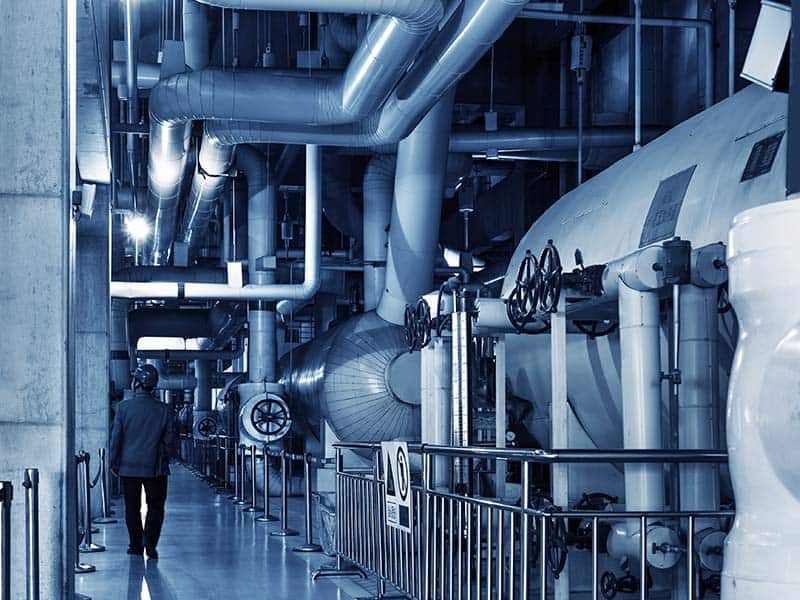
In early 2019, the New York City Council passed an ambitious package of energy-efficiency and emissions laws to help build more sustainable infrastructure throughout the city. The goal is admirable but, for facility managers and building owners, navigating this new and complex legal landscape can be difficult. React Industries’ HVAC solutions can help.
What Is Local Law 97 (LL97)?
Several years ago, New York City recently adopted the NYC Climate Mobilization Act, including Local Law 97, which sets out to substantially reduce emissions from over 57,000 buildings larger than 25,000 sq. ft. This is no small feat—by 2030 these structures must cut their CO2 output by 40% and 80% by 2050, or else face hefty fines starting in 2024!
Owners and facility managers of these buildings must take steps such as installing energy-efficiency equipment, replacing existing heating and cooling systems, and improving building insulation in order to meet their targets. Failure to comply with the law could result in fines of up to $2 million per year.
By implementing this law, New York City hopes to reduce its carbon emissions by 40% by the year 2030. Local Law 97 is a significant step towards reducing greenhouse gas emissions and creating a more sustainable future for generations to come. React Industries has the know-how to ensure owners are meeting their targets and fulfilling all necessary requirements without risking penalties.
What Compliance With Local Law 97 in NYC Requires
Compliance with Local Law 97 works in two initial stages. The first compliance period, between 2024 and 2029, will affect the most poorly performing buildings, about 20% by current estimates. Most of these buildings are older and were not designed with efficiency standards in mind, so they are not going to be subject to fines in 2024.
However, making a building over 25,000 square feet more energy efficient is a lengthy process and cannot be put off for long. In 2030, about 75% of buildings over 25,000 square feet will be subject to fines under the law. New requirements for future periods are yet to be determined, but the overall goal remains the same: an 80% reduction in emissions by 2050.
Your building type impacts the emissions levels you are required to meet. Hospitals and religious facilities, for example, will have different compliance requirements versus commercial and industrial buildings.
What Are the Fines for Noncompliance With Local Law 97?
Buildings that do not comply with the new limits set by Local Law 97 will be required to pay $268 per metric ton of CO2 that exceeds the allowed limit every year until the building is made more efficient. These fines also compound with other laws in the legislative package. For example, inspections and certifications as a part of Local Law 87 carry non-compliance fines as well.
All of this can be quite complicated and it’s easy to become overwhelmed with the details. Your HVAC system is one of the most energy-demanding systems in your facility, and React Industries can help you with meeting compliance requirements.
React Industries can help you navigate the compliance requirements enacted in Local Law 97.
Checklist for Complying with NYC Local Law 97
1. Assess Your Building’s Energy Usage and Carbon Emissions
- Calculate the building’s baseline energy use and carbon emissions from 2021 or 2022.
- Analyze the building’s energy consumption since then to determine its current performance.
2. Develop an Energy Efficiency Plan
- Create an action plan to reduce your building’s carbon footprint by 40% by the year 2030.
- Identify how you will measure and track your building’s energy efficiency goals.
3. Implement Energy Efficient Measures
- Consider transitioning to LED lighting, installing energy efficient equipment and appliances, and utilizing natural ventilation strategies.
- Explore renewable energy sources such as solar panels or wind turbines to power your building.
4. Monitor Progress
- Track your progress toward meeting the goals outlined in your Energy Efficiency Plan and update it as needed.
5. Report
- Submit an annual report to the city detailing your building’s energy consumption, efficiency measures implemented, and progress toward meeting goals.
6. Receive Certification
- Once you have met all of the requirements of Local Law 97, you will receive a certificate indicating that your building is compliant with the law.
7. Stay Compliant
- Continue to monitor your energy consumption and efficiency measures to ensure that you remain compliant with Local Law 97.
8. Seek Professional Assistance
- If necessary, seek professional advice and assistance to ensure that your building is in compliance with Local Law 97.
How Local Law 97 Relates to Local Law 87
Local Law 87 (LL87) is different, but highly related to Local Law 97. LL87 mandates that buildings over 50,000 square feet go through a process of energy-efficiency audit and retro-commissioning every 10 years. If building owners fail to have these audits conducted, they are subject to substantial fines.
One way to simplify all of this is to think again about the goal of all of these separate regulations. New York City is trying to reduce the city’s carbon footprint by 80% by 2050, and each of these regulations helps achieve that same goal. In other words, if building owners are trying to avoid the fines of LL87 by having their buildings retrofitted, they will be working toward compliance with LL97 and other laws in the package. By working with a provider like React Industries, you will be able to develop a long-term energy-efficiency strategy that will allow you to meet every compliance goal.
Local Law 97 Compliance and Your Facility
When regulators talk about your building’s carbon footprint, they are addressing the total amount of carbon dioxide produced when generating the energy your facility uses. It’s important to understand this because it clarifies that energy efficiency is the key to creating a more sustainable facility.
Contact React industries today to learn more about how our HVAC solutions can help you meet these compliance requirements, avoid fines, and create a more environmentally-friendly city.